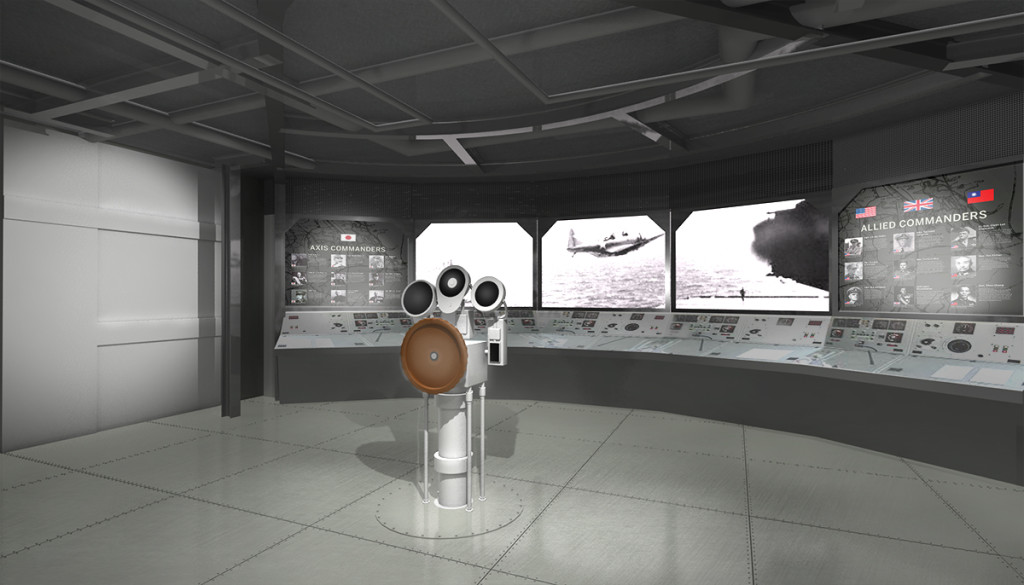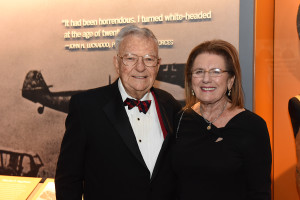Road to Tokyo Countdown: Pacific Briefing Room
 As we continue down the Road to Tokyo, we stop next at the Pacific Briefing Room, which will fully immerse visitors in the Pacific War.
As we continue down the Road to Tokyo, we stop next at the Pacific Briefing Room, which will fully immerse visitors in the Pacific War.
In the Briefing Room, visitors will learn about the massive gains of the Japanese in the first half of 1942 and the clobbering of the Allied forces, including the British surrender in Singapore and the American surrender in the Philippines. Dire losses had a galvanizing impact on the American people as they embraced values of courage, teamwork, and sacrifice to defend the nation and its democratic values.
Meanwhile, leaders in Washington devised a military strategy that divided the Pacific Theater and charted two paths to Japan – one that approached from the southwest, including the retaking of the Philippines and other islands before attacking Japan, and a second that reached directly across the central Pacific. In both cases, it was crucial that the US Navy secure sea lanes to halt the Japanese advance – requiring a new kind of naval warfare to succeed. Maps and newsreels will lead you through these challenges and strategies, and introduce you to the military leaders responsible for the Allied forces in the Pacific.
The Pacific Briefing Room has been made possible through a generous gift by Madlyn and Paul Hilliard.
Donor Spotlight: Madlyn and Paul Hilliard
For more than a decade, Museum trustee and WWII veteran Paul Hilliard and his wife, Madlyn, have been two of the Museum’s most active advocates and supporters. They have provided transformative support for several Museum initiatives, including the capital expansion, acquisition and restoration of artifacts, collection of oral histories, and education programs.
Paul is a Marine Corps veteran who served as a radioman/gunner in SBD “Dauntless” dive bombers in the Pacific. He turned 17 in June of 1942 and pleaded with his mother to authorize his enlistment in the Marines, finally, in February of 1943, she relented and Paul was shipped to boot camp in San Diego. After more than a year of training in aviation radio, radar and gunnery, he was sent to the Solomons for assignment to an SBD dive bomber squadron.
One of his most memorable experiences came when his unit was put aboard a retrofitted Australian cattle ship for transport from the Solomons to the Philippines—with brief stops at New Guinea and Ulithi. After joining the convoy at Ulithi carrying the support forces for the assault on Luzon, he says “we were given a very special ride on that old cattle scow when we encountered the tail end of a typhoon and the rough seas gave us a view of the bow of other ships in the convoy disappearing into the troughs while the screws came well out of the water. Most of the transports were towing barges loaded with bombs and munitions and when the typhoon abated in Philippine waters, very few of the barges could be seen.”
In the Philippines the SBDs served as “airborne artillery” for General Krueger’s Sixth Army, assigned to dive bomb and strafe targets assigned by the army units attacking the Japanese on the ground. He flew many “Columbus missions,” named this because “we were unaware where we were going when we took off, we didn’t where we were when arrived at the target and when we returned to base we didn’t know where we had been. We did it all at the government’s expense.”
The Hilliards have played a large role in assisting the Museum acquire and restore several of the Museum’s iconic warbirds and macroartifacts. They both feel passionately that seeing these artifacts up close is “different than seeing them on TV or in simulation.” Madlyn is always impressed by the faces of the children “so focused and interested in what they are seeing. They do not get this in a classroom, and it is so meaningful for all visitors to learn the price of freedom for our country.”
The two have sponsored a variety of artifacts within The National WWII Museum for this reason. The Hilliards have chosen to sponsor the SBD Dauntless in the US Freedom Pavilion: The Boeing Center, since this was the aircraft Paul frequently flew during his time in the war. The aircraft also has an added connection to the pair—the number 41 on the side of SBD Dauntless matches their street address in North Carolina.
Paul believes that the acquisition of enemy weapons and artifacts, like the Messerchmitt, is important in explaining the various sides of war. By exhibiting weapons used by the Axis enemies, it better clarifies the weaponry the Allied forces built and employed in response, in order to defeat the enemy. The Messerschmitt currently hangs in the Campaigns of Courage Pavilion.
In addition to the macroartifacts that the Hilliards have generously supported, they have also named two exhibits in the upcoming Road to Tokyo in the new Campaigns of Courage: European and Pacific Theaters—the Pacific Briefing Room and the Battle of Manila. Since Paul fought in the Pacific, particularly in the Battle of Manila, the two exhibits were an obvious choice for the pair. Paul, reflecting on his time in Manila, states that this mission consisted of a different type of bombing than the missions before. He did not know what kind of targets they were hitting and there was radio silence throughout the mission. He stated that the bombing of Manila felt more like a delivery for a very specific target. Since Paul was seated in the rear of the airplane, he witnessed the devastation that trailed behind the plane after the bombs were dropped. The battle was a disturbing one for the enemy, and something that has fascinated Paul ever since his role in it.
Paul states “to those of us who wore a uniform between1940 and 1946, it seemed as if nearly every man in America had served and so it was so normal, so commonplace, that the subject seldom surfaced. I credit Stephen Ambrose with reviving the discussion and the interest as his books shed light on specific anecdotes, on small-unit-actions, and on the long-lasting impact the War had and was going to have on world history. Once I began to realize that I had been privileged to play a minor role in an enormous event, I became and still am, an assiduous student of WWII. The National WWII Museum has been and is an incredible opportunity to further my interest and to help tell the story of “the war that changed the world.”
The continuous support of Paul and Madlyn attests to their interest in and commitment to telling the story. Madlyn says, “what is so rewarding about [the Museum], is its growth and the enthusiasm of the young visitors, their amazing knowledge of events in the War and their enjoyment of their visit. It’s contagious!!”
Paul says the Museum “tells the story of American at its best and of not only what Americans did during that War to ensure the freedom of millions around the world but to assure later generations that when fascism tackles freedom, freedom is going to come out on top. And whatever we have done or are doing to assist in spreading and trumpeting that message, is done from a sense of gratitude rather than from generosity.”
- Posted :
- Post Category :
- Tags :
- Follow responses to this entry through the RSS 2.0 feed. You can skip to the end and leave a response. Pinging is currently not allowed.





Leave a Reply